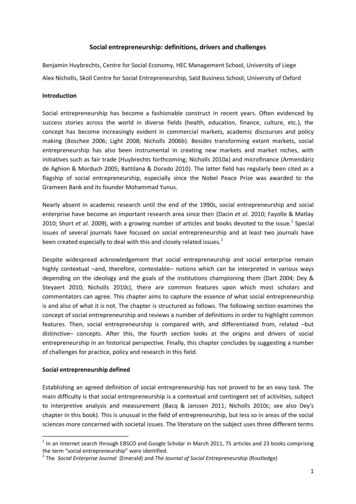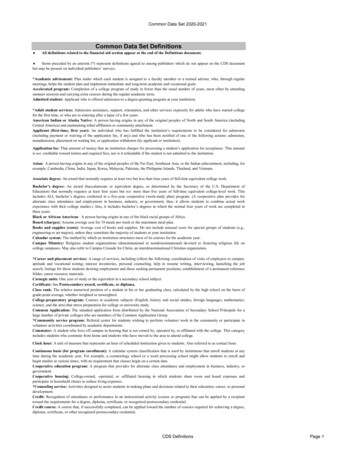
Transcription
Social entrepreneurship: definitions, drivers and challengesBenjamin Huybrechts, Centre for Social Economy, HEC Management School, University of LiegeAlex Nicholls, Skoll Centre for Social Entrepreneurship, Saïd Business School, University of OxfordIntroductionSocial entrepreneurship has become a fashionable construct in recent years. Often evidenced bysuccess stories across the world in diverse fields (health, education, finance, culture, etc.), theconcept has become increasingly evident in commercial markets, academic discourses and policymaking (Boschee 2006; Light 2008; Nicholls 2006b). Besides transforming extant markets, socialentrepreneurship has also been instrumental in creating new markets and market niches, withinitiatives such as fair trade (Huybrechts forthcoming; Nicholls 2010a) and microfinance (Armendárizde Aghion & Morduch 2005; Battilana & Dorado 2010). The latter field has regularly been cited as aflagship of social entrepreneurship, especially since the Nobel Peace Prize was awarded to theGrameen Bank and its founder Mohammad Yunus.Nearly absent in academic research until the end of the 1990s, social entrepreneurship and socialenterprise have become an important research area since then (Dacin et al. 2010; Fayolle & Matlay2010; Short et al. 2009), with a growing number of articles and books devoted to the issue.1 Specialissues of several journals have focused on social entrepreneurship and at least two journals havebeen created especially to deal with this and closely related issues.2Despite widespread acknowledgement that social entrepreneurship and social enterprise remainhighly contextual –and, therefore, contestable– notions which can be interpreted in various waysdepending on the ideology and the goals of the institutions championing them (Dart 2004; Dey &Steyaert 2010; Nicholls 2010c), there are common features upon which most scholars andcommentators can agree. This chapter aims to capture the essence of what social entrepreneurshipis and also of what it is not. The chapter is structured as follows. The following section examines theconcept of social entrepreneurship and reviews a number of definitions in order to highlight commonfeatures. Then, social entrepreneurship is compared with, and differentiated from, related –butdistinctive– concepts. After this, the fourth section looks at the origins and drivers of socialentrepreneurship in an historical perspective. Finally, this chapter concludes by suggesting a numberof challenges for practice, policy and research in this field.Social entrepreneurship definedEstablishing an agreed definition of social entrepreneurship has not proved to be an easy task. Themain difficulty is that social entrepreneurship is a contextual and contingent set of activities, subjectto interpretive analysis and measurement (Bacq & Janssen 2011; Nicholls 2010c; see also Dey'schapter in this book). This is unusual in the field of entrepreneurship, but less so in areas of the socialsciences more concerned with societal issues. The literature on the subject uses three different terms1In an Internet search through EBSCO and Google Scholar in March 2011, 75 articles and 23 books comprisingthe term “social entrepreneurship” were identified.2The Social Enterprise Journal (Emerald) and The Journal of Social Entrepreneurship (Routledge)1
which, at first sight, might seem linked in a very simple way: “social entrepreneurship” is the dynamicprocess through which specific types of individuals deserving the name of “social entrepreneurs”create and develop organizations that may be defined as “social enterprises” (Defourny & Nyssens2008b; Mair & Marti 2006). However, the use of one term or the other is often linked to a differentfocus and/or understanding of the phenomenon depending on context and perspective. In thischapter, “social entrepreneurship” will be used to designate a broader range of socially innovativeinitiatives in a spectrum from for-profit to voluntary organizations. “Social enterprises” are a subsetof such activities in which commercial models are used as the vehicle by which social objects areachieved (Nicholls 2006b; Thompson 2008).The study of social entrepreneurship has developed quite differently in the ‘Anglo-sphere’ of the UKand US compared with continental Europe. In the former, the focus has been on thecommercialization of the not-for-profit sector and on private initiatives that can deliver publicwelfare goods. In the latter, the focus has been much more on collective entrepreneurship andanalyses at the organizational level (Defourny & Nyssens 2008a; Kerlin 2006; 2008). However, inmore recent years, these regional differences seem to have been blurring as better dialogues haveevolved between the two traditions facilitated by a new set of academic events such as the SocialEntrepreneurship Research Colloquium (Bacq & Janssen 2011; Defourny & Nyssens 2008a; Hulgard2008; Kerlin 2006).In reality, the diversity of discourses that characterize the definitional debates around socialentrepreneurship reflect the internal logics of a broad range of influential, resource holding actorswho are actively involved in shaping the field, rather than any attempts at capturing the ‘reality’ ofthe field itself (Dart 2004; Dey & Steyaert 2010; Nicholls 2010c). Thus, for civil society actors, socialentrepreneurship may represent a driver of systemic social change (Nicholls 2006), a space for newhybrid partnerships (Austin et al. 2006a), or a model of political transformation and empowerment(Alvord et al. 2004). For government, social entrepreneurship (particularly in the form of socialenterprises) can be one of the solutions to state failures in welfare provision (Leadbeater 1996;Nyssens 2006). Finally, for business, social entrepreneurship can offer a new market opportunity(Karamchandani et al. 2009) or a natural development from socially responsible investment(Freireich & Fulton 2009).In Kuhnian terms, the lack of a unified definition is characteristic of a field which is still in an earlystage of development and has not yet achieved paradigmatic status (Nicholls 2010c). Dacin et al.(2010) counted 37 definitions of social entrepreneurship or social entrepreneurs. Bacq and Janssen(2011) noted 17 different definitions of “social entrepreneurs”, 12 definitions of “socialentrepreneurship” and 18 definitions of “social enterprise”, “social entrepreneurial venture” or“social entrepreneurship organization”.One key debate has concerned how broad or narrow the scope of social entrepreneurship might be(Light 2008), reflecting Dees’ (1998; 2001) call for an equilibrium between inclusiveness (definingsocial entrepreneurship very broadly) and exclusiveness (defining it very narrowly). An extremeresponse to this apparent confusion over definitions has been to suggest –contra empiricalevidence– that there is nothing theoretically distinctive about social entrepreneurship whencompared to entrepreneurship more generally (Dacin et al., 2010).2
Despite continued debates, one of the most commonly used definitions was provided by Dees (1998,revised 2001:“Social entrepreneurs play the role of change agents in the social sector, by:–––––Adopting a mission to create and sustain social value (not just private value),Recognizing and relentlessly pursuing new opportunities to serve that mission,Engaging in a process of continuous innovation, adaptation, and learning,Acting boldly without being limited by resources currently in hand, andExhibiting a heightened sense of accountability to the constituencies served and for theoutcomes created” (2001:4)Subsequent work focussed on the processes of social entrepreneurship. According to Mort et al.(2003: 76), social entrepreneurship is “a multidimensional construct involving the expression ofentrepreneurially virtuous behaviour to achieve the social mission, a coherent unity of purpose andaction in the face of moral complexity, the ability to recognise social value-creating opportunities andkey decision-making characteristics of innovativeness, proactiveness and risk-taking”. Mair and Marti(2004:3) view social entrepreneurship as “a process consisting of the innovative use and combinationof resources to explore and exploit opportunities, that aims at catalysing social change by catering tobasic human needs in a sustainable manner”. Austin et al. (2006b: 2) define social entrepreneurshipas an “innovative, social value creating activity that can occur within or across the nonprofit,business, or government sectors”. Finally, Zahra et al. (2009: 5) suggest that social entrepreneurshipencompasses “activities and processes undertaken to discover, define, and exploit opportunities inorder to enhance social wealth by creating new ventures or managing existing organizations in aninnovative manner”.Despite these ongoing disputes and debates, there remains some broad agreement about a numberof key characteristics that set the boundaries of socially entrepreneurial action (Martin & Osberg2007; Nicholls 2006a). All the definitions of social entrepreneurship agree on a central focus on socialor environmental outcomes that has primacy over profit maximization or other strategicconsiderations. A second defining feature is innovation. Innovation can be pursued through neworganizational models and processes, through new products and services, or through new thinkingabout, and framing of, societal challenges. Several social entrepreneurship initiatives combine thesedifferent ways of innovating. Finally, many authors emphasize how social entrepreneurs diffuse theirsocially innovative models via market oriented action that is performance driven, scaling up theirinitiatives in other contexts through alliances and partnerships, with the idea of reaching broader andmore sustainable outcomes. These dimensions map onto what Nicholls and Cho (2006) identify asthe main building blocks of social entrepreneurship: sociality, innovation, and market orientation.The first dimension, “sociality”, refers to the social and environmental focus of socialentrepreneurship. Such a focus may be identified through the creation of public goods and positiveexternalities. Six fields or domains are natural settings for social entrepreneurship initiatives: (1)welfare and health services (such as the Aravind eye hospitals in India); (2) education and training(such as the Committee to Democratize Information Technology in Brazil); (3) economic development(such as work integration social enterprises, or WISEs, in Europe); (4) disaster relief and international3
aid (such as Keystone’s innovative “Farmer Voice” project); (5) social justice and political change(including race and gender empowerment, such as SEWA, the Self-Employed Women’s Association inPakistan); (6) and environmental planning and management (such as the Marine StewardshipCouncil).But sociality may also lie in the organizational processes themselves. Indeed, socially innovativesolutions have been pioneered by social entrepreneurs in terms of employment practices (WISEsemploying low-skilled workers), supply chain management (a good example is Fair Trade), energyusage and recycling (such as citizen-based renewable energy cooperatives), and access to credit andfinancial services (different types of microfinance). Finally, sociality may be identifiable in theoutcomes of the organization which will be focussed on social and/or environmental impact ratherthan on financial returns. In order to capture these outcomes, the field of social entrepreneurshiphas pioneered a range of new performance evaluation criteria and methods that take into accountthese non-financial impacts (Stone & Cutcher-Gershenfeld 2001).Regarding the second characteristic of social entrepreneurship, innovation, it is interesting to notethat its approach in social entrepreneurship has much in common with models found in commercialentrepreneurship. For example, in some cases, Schumpeter’s idea of “creative destruction” processesthat change systems and realign markets around new economic equilibriums can also be found insocial entrepreneurship initiatives, either through incremental changes at the micro-level or throughdisruptive interventions at the systems level (Martin & Osberg 2007).Third, market orientation is manifest in a variety of ways in social entrepreneurship, most obviouslyin the for-profit social enterprise form, which operates in commercial markets and generates profitsto reinvest in their social mission (Alter 2006). Defourny (2001) and other authors from the EMESnetwork suggest that social enterprises, unlike traditional NGOs and nonprofits, have a continuousproduction of goods and/or services and take economic risks – bankruptcy is always a possibleoutcome. A minimum amount of paid work, i.e., a workforce not only composed of volunteers, is alsosuggested as an element differentiating social enterprise. Nicholls and Cho (2006) identify otherfeatures that extend the market orientation dimension, notably a clear focus on continualperformance improvement and metrics, increased accountability, and a relentless focus on achievingtheir mission that permeates the entire organizational culture.Based on how social enterprises integrate these building blocks, different typologies of socialentrepreneurship have been proposed. In 2000, Fowler suggested three types of socialentrepreneurship: ‘integrated’ (when economic activity in itself produces social outcomes); ‘reinterpreted’ (when an existing not-for-profit increases its earned income); and ‘complementary’(where commercial revenues cross-subsidize the social mission of a related not-for-profit). In asimilar exercise, Alter (2006) distinguishes social enterprise models based on their missionorientation (from mission-oriented to profit-oriented), on their target group, and on how the socialprograms and the business activities relate to each other. Alter identifies three core models of socialenterprise: embedded (when social programs are inherent in the business activities, as in Fair Trade);integrated (when social programs overlap with business activities, for instance at the ScojoFoundation in India); and external (when business activities are an external source of funding forsocial programs, typically in health or education not-for-profits).4
What social entrepreneurship is notHaving established the key definitional dimensions of social entrepreneurship, this section willexplore alternative notions which differ from social entrepreneurship to a certain extent – thoughthe latter’s boundaries are still contested (see Dey further in this book). Four notions of relevancewill be discussed below: social entrepreneurship is not a discrete sector; it is not a synonym of socialbusiness; it is not a new form of corporate social responsibility; and it is not the only model of socialinnovation.Not a discrete sectorMuch social entrepreneurship has been identified as a boundary blurring form of action between theideal types of the private, public and civil society sectors. For example, whilst a good deal of socialentrepreneurship has its roots in civil society, there has been an evolution towards a stronger marketorientation in recent years (Monaci & Caselli 2005). This links to the notion of the ‘social economy’ aswidely used in continental Europe, Canada and other parts of the world. The social economyencompasses organizations which are located between the public sector and the for-profit businesssector. Characteristic of a social economy organization is “to provide services to its members or to awider community, and not serve as a tool in the service of capital investment [ ]. The generation of asurplus is therefore a means to providing a service, not the main driving force behind the economicactivity” (Defourny et al. 2000, 16).However, the social economy is both a broader and a narrower concept than socialentrepreneurship. It is broader because it includes organizations which are not necessarilyentrepreneurial and do not necessarily rely on market resources. In fact, the same remark can bemade for not-for-profit organizations, which are not all entrepreneurial. On the other hand, thesocial economy can be seen as narrower than social entrepreneurship because it only includesorganizations with specific legal forms: not-for-profits/charities, cooperatives, mutuals andfoundations. It thus ignores the social enterprises which have not adopted one of these forms andwhich do not formally limit profit distribution. Other examples and models of social entrepreneurshipincorporated as small and/or family businesses, located in the public sector and in the corporateworld, and resulting from partnerships with and between these sectors also blur the association ofsocial entrepreneurship with the civil society and social economy sectors. Moreover, the levels ofanalysis are clearly diverging. The social economy refers to a field or a sector (the “third sector”) in astatic way. Social entrepreneurship is not a discrete sector, it is a set of hybrid organizations andprocesses, which may take place in different institutional spaces between and across existing sectors.Not a synonym for social businessAlthough the term “social business” has been used earlier than that of social entrepreneurship, itsdiffusion is more recent and is mainly due to Nobel Peace Prize winner Muhammad Yunus, founderof the Grameen Bank. Yet, it has not yet received much attention in the academic literature, despiteYunus’ own writings (Yunus 2006; 2007; Yunus et al. 2010).At first sight, the way in which Yunus describes a social business might seem quite similar to theprinciples of a social enterprise: “a company that is cause-driven rather than profit-driven, with the5
potential to act as a change agent for the world” (Yunus 2007: 22). However, when we look at thedistinctive features of social business he sets out, it appears that this concept is much morerestrictive than social entrepreneurship or social enterprise. First, while social enterprise considersmission-aligned profit distribution, Yunus suggests that such profit distribution is prohibited in asocial business: “the investors who support it do not take any profits out of the company” (Yunus2007: 22). Social businesses are thus submitted to the “nondistribution constraint” which is moretypical of not-for-profit organizations (Hansmann 1980). But unlike not-for-profits, social businessesare required to raise all their incomes and recover all their costs through the market, and notthrough philanthropy or public funding.Through emphasizing “full cost recovery” as a criterion which distinguishes social business fromcharity, Yunus ignores the possible hybridization of social and business logics which lies at the heartof many social enterprises (Billis 2010; Di Domenico et al. 2010; Huybrechts forthcoming). Yunus’emphasis on market income3, while finding some echo in certain conceptions of socialentrepreneurship, lies at odds with the mixed income models described by a majority of socialentrepreneurship scholars (Bacq & Janssen 2011). 4 Finally, it should be noted that the social businessexamples cited by Yunus still mainly consist of partnerships between the Grameen Bank andmultinational business such as Danone, Veolia and Siemens. One may thus wonder whether theconcept Yunus promotes has a broader empirical basis beyond the initiatives specifically framed inthis way.Not a new form of corporate social responsibilityA third concept that might be confused with social entrepreneurship is corporate socialresponsibility. According to the European Union (Lisbon strategy), CSR refers to “*a concept wherebycompanies integrate social and environmental concerns in their business operations and in theirinteraction with their stakeholders on a voluntary basis”5. In its integration of social aims in thebusiness realm and in the innovative nature of some of its initiatives, CSR might be considered closeor even a synonym of social entrepreneurship. Adopting this view, Baron (2007) labels initiators ofCSR projects as “social entrepreneurs”. Without going as far in the association of the concepts, Austinand his colleagues suggest that social entrepreneurship “is for corporations, too” (Austin et al.2006a) and labels this as “corporate social entrepreneurship” (Austin & Reficco 2005).However, two elements differentiate social entrepreneurship from CSR. First, CSR is not necessarilyentrepreneurial nor innovative. CSR may indeed consist of aligning corporate practices with practicesand norms which are long established (including law), thereby lacking innovativeness. Secondly, therespective goals of CSR projects and social entrepreneurship fundamentally diverge. In socialentrepreneurship, the social mission has primacy and profits are means to reach this mission; itshould, thus, be at least partly reinvested in the project rather than mainly appropriated by3E.g.: “Once a social project has overcome the gravitational force of financial dependence, it is ready for spaceflight” (Yunus 2007: 23)4Several authors criticize the myth that relying only market incomes brings independence and sustainability(Battle Anderson & Dees 2006; Dart 2004). They suggest either having a relaxed view on income sources orstriving towards hybrid resource mixes (Gardin index en.htm,viewed on 16 May 2011.6
shareholders. In corporations, however responsible, profit maximization remains the ultimate goaland is directed towards shareholder value appropriation. Hence, beyond the respective positions ofprofit and social mission, it is the issue of value appropriation that differentiates socialentrepreneurship from CSR (Santos 2009). Of course, such a distinction may not be easy to establishempirically and the question of what proportion of CSR initiatives may be labelled as corporate socialentrepreneurship remains open to debate.Not the only model of social innovationSocial innovation is another concept which has gained increasing attention recently (Martin & Osberg2007; Mulgan et al. 2007; Phills et al. 2008). Drawing on the literature on innovation and on its broadconceptualization by Schumpeter, Nicholls (2010a:247) distinguishes three types of social innovation:“in new product and service development (institutional innovation); in the use of existing goods andservices in new –more socially productive– ways (incremental innovation); in reframing normativeterms of reference to redefine social problems and suggest new solutions (disruptive innovation)”.While much of the literature has focused on innovation as inherent in entrepreneurship and marketorientation, the concept of social innovation tends to consider innovation in a much broader way.Social innovation, broadly defined as new solutions to social needs, is not necessarily market-basedand can be found in any sector (Mulgan et al. 2007; Phills et al. 2008): public (example ofparticipative budgeting in Porto Alegre and elsewhere, see for instance Novy & Leubolt 2005), privatefor-profit (Austin et al. 2006), or non-profit (Gerometta et al. 2005). In such sense, whilst socialentrepreneurship and social innovation clearly overlap, a difference lies in the fact that socialinnovation is not necessarily market oriented, while social entrepreneurship clearly is. Hence, someauthors view social innovation as the broader umbrella term under which social entrepreneurship, aswell as other novel public and third sector initiatives located outside the market, can be affiliated(Mulgan et al. 2007; Phills et al. 2008).The drivers of social entrepreneurshipWhilst interest in social entrepreneurship is growing, it is not a new phenomenon. Examples oforganizations demonstrating the three building blocks of social entrepreneurship (sociality,innovation and market orientation) can be found throughout history and across geographicalsettings. For example, figures as diverse as Robert Owen (one of the fathers of the co-operativemovement), Vinoba Bhave (one of Ghandi’s disciples) and Jean-Baptiste André Godin (a Frenchentrepreneur who provided extensive and innovative social welfare services to his workers) aretypical figures of 19th century social entrepreneurs that conform to the definitions discussed here(Boutillier 2009; Mulgan et al. 2007).Nevertheless, the specific identification of certain actors and activities with social entrepreneurship isa recent matter, with the term itself only beginning to emerge in the 1970s. During the 1980s and1990s field building organizations emerged that focussed exclusively on social entrepreneurship (e.g.,Ashoka (founded in 1981), the Schwab Foundation (1998), the Skoll Foundation(1999), UnLtd (2002),the Omidyar Network (2004), and the Young Foundation (2006): see Nicholls, 2010c). At the sametime, government policy in several countries began to explore the possibilities of the field in terms ofwelfare provision as well (Dees 1998; Dees & Elias 1998; Leadbeater 1996). The nomination of7
Muhammad Yunus and the Grameen Bank as Nobel Prize for Peace winners has been seen by manyas a turning point in the global recognition of social entrepreneurship (Martin & Osberg 2007) andsocial innovation in general (Mulgan et al. 2007).But beyond the activities of field-building organizations, some major changes in socio-economic,political and cultural contexts across the world have also acted as drivers of the recent accelerationin the growth of socially entrepreneurial discourses and in practices. First, the proliferation of globalcrises has driven demand for innovative social and environmental action able to respond to the newchallenges posed by these so-called ‘wicked problems’ (Bornstein 2004). Major challenges include:climate change and environmental degradation; inequality and poverty; lack of access to basichealthcare, clean water and energy; mass migration; international terrorism.Secondly, the rise of global connectedness has improved the ability of citizens to identify andrespond to social and environmental needs. The rise of new social media has also accelerated andintensified the interactions among social entrepreneurs, funders and other stakeholders. Theinvolvement of individuals as social actors can be linked to the development of a “pro-am” culture(Leadbeater 2006) and the emergence of “new localism” (Murray et al. 2010).A third major driver has been the redefinition of the role of the state, starting with the rise of neoconservative politics in the 1980s (Grenier 2009). In the context of “new public management”, thesepolitics encouraged a more managerialist functioning of the state (Osbourne & Gaebler 1992) andthe creation of internal “quasi-markets” within state welfare systems (Bode et al. 2011; Flynn &Williams 1997; Le Grand 1991). Not-for-profits were encouraged to compete with each other (andoften with for-profit businesses) to contract with the government. Increasingly, discourses ofenterprise were decoupled from business and applied not only to the activities of the public sectorbut also to civil society action more generally (Dart 2004). Thus, market failures in the provision ofwelfare services led to new opportunities for social entrepreneurs (in health, education, etc.).Finally, the combination of the proliferation of not-for-profits and other civil society organizations(Salamon et al. 2003) and several economic recessions, lead to a growing mismatch between thesupply and demand of resources to sustain social organizations. This has led civil societyorganizations to become more entrepreneurial and to diversify their funding by seeking commercialrevenues and new partnerships with the state and the business sectors (Kanter & Summers 1987). Asa result, successful social entrepreneurs have managed to reduce their dependence on the stateand/or donors via new social enterprise models. However, the negative consequences of dependingon market resources have also been pointed out (Battle Anderson & Dees 2006; Dart 2004).The size and scope of the field of social entrepreneurshipSocial entrepreneurship is not characterized by a single legal form. Specific legal forms do exist forsocial entrepreneurship, such as the Social Purpose Company in Belgium, the Community InterestCompany (CIC) form in the United Kingdom, Social Cooperatives (Types 1 and 2) in Italy, and L3Corganizations in the US. The field, however, also includes a variety of other legal forms (cooperatives,nonprofits, businesses, etc.), some of which are combined in the context of hybrid structures. As aconsequence, it has proved to be a significant challenge to derive consistent data on the size andscope of social entrepreneurship across countries.8
Nevertheless, attempts have been made to give a snapshot of the field in different contexts,particularly in the UK where there has been a large interest in, and support for, the field. A survey forthe UK government estimated the number of social enterprises as 62,000 across the country,contributing 24 billion Gross Value Added to the economy from 2005 to 2007 (Williams & Cowling2009). At the international level, the Global Entrepreneurship Monitor (GEM) survey is a valuablesource of information. The GEM 2010 survey took, for the first time, a worldwide perspective onsocial entrepreneurship (Bosma & Levie 2010). It estimated that an average of 1.9% of the populationdirectly engaged with social entrepreneurship, with important differences depending on the regionconcerned and its level of economic development.To build a picture of the scale of social entrepreneurship in specific contexts, it is instructive to lookat some of its well-established sub-fields. For example, Dees (2010) provides some impressive figuresabout the Bangladesh Rural Advancement Committee (BRAC): it runs more than 37,000 schools, with120,000 workers, 80,000 health volunteers, it offers microfinan
main difficulty is that social entrepreneurship is a contextual and contingent set of activities, subject to interpretive analysis and measurement (Bacq & Janssen 2011; Nicholls 2010c; see also Dey's chapter in this










